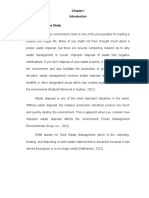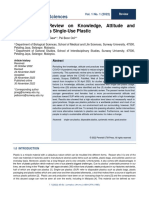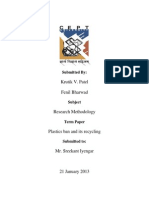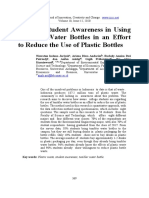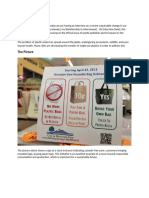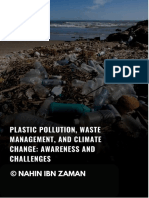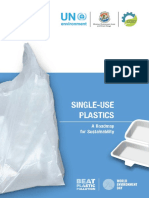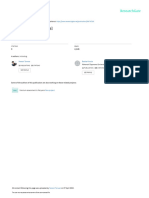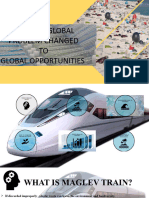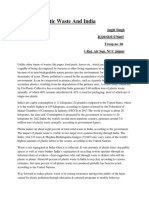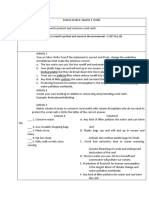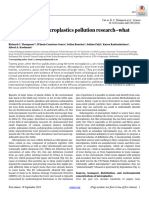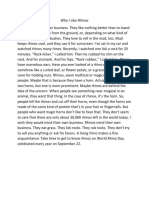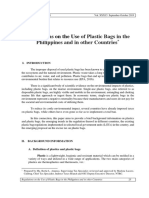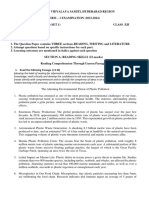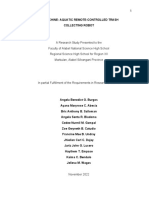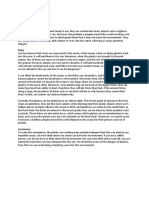Plastic Pollution in India: An Evaluation of Public Awareness and Consumption Behaviour
Plastic Pollution in India: An Evaluation of Public Awareness and Consumption Behaviour
Uploaded by
Biprajit PaulCopyright:
Available Formats
Plastic Pollution in India: An Evaluation of Public Awareness and Consumption Behaviour
Plastic Pollution in India: An Evaluation of Public Awareness and Consumption Behaviour
Uploaded by
Biprajit PaulOriginal Title
Copyright
Available Formats
Share this document
Did you find this document useful?
Is this content inappropriate?
Copyright:
Available Formats
Plastic Pollution in India: An Evaluation of Public Awareness and Consumption Behaviour
Plastic Pollution in India: An Evaluation of Public Awareness and Consumption Behaviour
Uploaded by
Biprajit PaulCopyright:
Available Formats
Plastic Pollution in India: An Evaluation of Public
Awareness and Consumption Behaviour
Kanwal D. P. Singh 1, Aakriti Mathur 2
1,2
University School of Law and Legal Studies, Guru Gobind Singh Indraprastha University,
Sector 16C Dwarka, New Delhi, India,
Corresponding author: 1 email id:Kanwal.als@gmail.com 2 email id:aakritimathur14@gmail.com
© Authour(s)
OIDA International Journal of Sustainable Development, Ontario International Development Agency, Canada
ISSN 1923-6654 (print) ISSN 1923-6662 (online) www.oidaijsd.com
Also available at http://www.ssrn.com/link/OIDA-Intl-Journal-Sustainable-Dev.html
Abstract: Plastic is a cost-effective, durable and easy to manufacture material and its usefulness
and convenience has resulted in its ever-increasing demand. The demand for plastics has also been
fuelled by the rise of the ‘use-and-throw’ culture resulting in much of the plastics being designed
to be disposed after just one use. These single-use plastics, mostly used as packaging material,
account for a substantial chunk of the total plastics manufactured today. However, most plastic is
non-biodegradable and it takes up to a thousand years for certain types of plastics to decompose
resulting in accumulation of plastic waste, much of it ending up in oceans, causing adverse
consequences marine life. The scale of plastic pollution has become alarming with millions of
tonnes of plastic waste existing in oceans today. Single-use plastics are the responsible much of
this plastic waste and individual consumption behaviour and habits must change to reduce their
demand. Presently more than 120 states across the world have some form of regulation on the use
of certain types of single-use plastic. India has adopted plastic waste management rules and is
committed to abolish all single use plastics in India by the year 2022. While regulating the
manufacture and use of these single-use plastics through bans and taxes can influence consumer
behaviour, these regulatory policies would be most effective when coupled with increasing the
public awareness regarding the risks and harmful effects of plastic pollution, the need for such
regulatory policies and the significant impact individual consumption choices can have on
reducing the individual’s plastic consumption. This paper examines the public attitudes to
combating plastic pollution in India, extent of awareness of plastic pollution, level of public
satisfaction with government policy relating to plastic pollution and individual plastic
consumption behaviour. The methodology adopted in this research paper is empirical and
analytical and the authors will collect primary data through the means of a questionnaire to
evaluate the public attitudes to combating plastic pollution in India, extent of awareness of plastic
pollution, level of public satisfaction with government policy relating to plastic pollution and
individual plastic consumption behaviour. The questionnaire was administered to a random
sample of 110 respondents belonging to the age group of 18 – 77 years, selected from urban areas
in India. The research paper shall examine the public attitudes to combating plastic pollution in
India, extent of awareness of plastic pollution, level of public satisfaction with government policy
relating to plastic pollution and individual plastic consumption behaviourand make
recommendations for effective outreach programs regarding plastic pollution in India.
Keywords: Attitude to Plastic Pollution; Plastic Consumption Behaviour; Plastic Pollution
Awareness.
Introduction
T he convenience of plastic has resulted in its rampant use in almost all aspects of human life and while the
usefulness of plastic cannot be underestimated, the resultant generation of plastic waste has created a massive
environmental challenge, since one of plastics main advantage its long life due to its non-biodegradability
also means that the all the plastic ever manufactured is still accumulating somewhere, much of it ending up in
oceans. According to a Joint Group of Experts on the Scientific Aspects of Marine Environmental Protection Report
(Kershaw, 2015), majority of plastics “do not biodegrade but instead they photodegrade by breaking down into
Electronic copy available at: https://ssrn.com/abstract=3548729
26 Singh and Mathur / OIDA International Journal of Sustainable Development, 12:07, 2019
small fragments called microplastics, which are small pieces of plastic found in the ocean, commonly defined as
being < 5mm in diameter”[1].The demand has grown exponentially over the years and more than 50% of the plastic
ever produced has been produced after the year 2000(Parker, 2018)[2]. This means that in the lasttwo decades we
have generated than the preceding 5 decades. Plastic manufacturing is dependent on fossil fuels and according to a
report(World Economic Forum, 2016), if current trends continue, “by 2050 the plastic industry may account for 20%
of the world’s total oil consumption”[3].Thus, plastic production also contributes to global warming and climate
change in addition to its other adverse environmental impacts.The problem of plastic waste is exacerbated by the use
of single use plastics meant for immediate disposal usually in the form of plastic packaging, carry bags, food
packaging, plastic bottles, straws, cutlery and containers. In 2015, according to a study (Roland Geyer, 2017), 47%
of the global plastic waste generated constituted plastic packaging [4].Mismanagement of plastic waste results it
being ingested by birds and animals. It also results in toxic plastic chemicals entering the food chain leading to
various adverse health impacts. Burning of plastics also results in toxic emissions resulting in adverse health
impacts. Minimising the use of single use plastics would be an effective way of reducing plastic waste and its
adverse impacts and many countries in the world now regulate single use plastics. According to a UN Environment
report (Carole Excell, 2018) more than 120 counties regulate the use plastic bags, more than 25 counties have partial
or full bans on the use of single use plastic, and almost 30 counties have enacted some type of tax on single-use
plastics and more than 60 countries haveExtended Producer Responsibility (EPR) measures in place relating to
plastics [5].On 5th June 2018, as per newspaper reports(Mohan, 2018), on the occasion of World Environment Day,
India announced its commitment to abolish all single use plastics.[6] According to reports(Dutta, 2018),more than
20 Indian States have either a complete or partial ban on plastic bags, however these bans are not being properly
implemented.[7] India has also adopted the Plastic Waste Management Rules, 2016 (Government of India,
2016)which have increased the thickness of plastic carry bags from 40 to 50 micron, introduced a collect back
system based on Extended Producers Responsibility, provided for Manufacture and use of non-recyclable multi-
layered plasticand also imposed a pre-registration fees on shopkeepers and street vendors willing to provide plastic
carry bags on payment of plastic waste management fee of minimum Rs. 48, 000/- at the rate of Rs. 4,000/- per
month [8]. The amended Plastic Waste Management Rules of 2018 (Government of India, 2018), laid down that the
phasing out of Multi-layered Plastic (MLP) is now applicable to MLP, which are “non-recyclable, or non-energy
recoverable, or with no alternate use”(Government of India, 2018) [9]. In addition to proper implementation of laws
relating to plastic waste management, the problem of plastic pollution, especially due to the use of single-use
plastics can also be addressed by modifying individual consumption behaviour. Raising public awareness regarding
the scope of plastic pollution, the risks, harmful effects of plastic and domestic regulatory policies would be
effective in promoting attitudes and consumption habits consistent with reducing plastic pollution and the
Government of India, must undertake initiatives to raise awareness regarding the same.
Methodology
This paper examines the public attitudes to combating plastic pollution in India, extent of awareness of plastic
pollution, level of public satisfaction with government policy relating to plastic pollution and individual plastic
consumption behaviour. The methodology adopted in this research paper is empirical and analytical and the authors
have collected primary data through the means of a questionnaire to evaluate the public attitudes to combating
plastic pollution in India, extent of awareness of plastic pollution, level of public satisfaction with government
policy relating to plastic pollution and individual plastic consumption behaviour. The questionnaire was
administered to a random sample of 110 respondents belonging to the age group of 18 – 77 years, selected from
urban areas in India. The questionnaire had 40 questions and was divided into 6 parts
a. Part I had 5 questions related to attitudes to plastic pollution.
b. Part II had 5 questions on awareness regarding scope of plastic pollution
c. Part III 5 questions on awareness regarding harmful effects of plastic pollution
d. Part IV had 5 questions on awareness regarding India's response to plastic pollution
e. Part V had 5 questions on evaluation of India's response to plastic pollution
f. Part VI 15 questions on consumption behaviour.
Part I had questions number 1-5 related to attitude to plastic pollution and each question had 5 options for indicating
their opinion on the statements given. These options included strongly agree, agree, neutral, disagree and strongly
disagree options. For questions 1,3,4 and 5 the answer that corelated with the most positive attitude towards
combating plastic pollution was strongly agree and was allotted 5 points and the answer that corelated with the least
positive attitude towards combating plastic pollution was allotted a score of 1 point. For question number 2 this
Electronic copy available at: https://ssrn.com/abstract=3548729
Singh and Mathur / OIDA International Journal of Sustainable Development, 12:07, 2019 27
order was reversed. Thus, each question related to attitude to plastic pollution was scored out of 25 points. Part II
had question number 6-10 related to awareness regarding scope of plastic pollution. Each question had only yes or
no options. Scores were assigned to all questions with 1 point for each response indicating awarenessregarding
scope of plastic pollution. Part III had question number 11-15 related to awareness regarding harmful effects of
plastic pollution. Each question had only yes or no options. Scores were assigned to all questions with 1 point for
each response indicating awareness regarding harmful effects of plastic pollution. Part VI had question number 16-
20 related to awareness regarding India's response to plastic pollution. Each question had only yes or no options.
Scores were assigned to all questions with 1 point for each response indicating awareness regarding India's response
to plastic pollution. Part V had question number 21-25 related to evaluation of India's response to plastic pollution.
Each question had 6 options. These options included i. Much less needs to be done showing highest level of
satisfaction with existing government policy which was allotted 5 points; ii. less needs to be done showing high
level of satisfaction with existing government policy which was allotted 4 points; iii. It is adequate showing
satisfaction with existing government policy which was allotted 3points; iv. More needs to be done showing
dissatisfaction with existing government policy which was which was allotted 2 points; v. Much more needs to be
done showing high dissatisfaction with existing government policy which was which was allotted 1 point; and vi.
Not aware showing lack of awareness of any governmental policy which was allotted 0 points. Part VI had question
number 26-40 related to plastic consumption behaviour. Each question had yes, no and not aware options. Scores
were assigned to all questions with 1 point for each consumption habit or behavior that contributes to reduction of
individual plastic waste.
Discussion and Findings
1.1. Demographic Details of Respondents. The demographic details regarding age, gender, highest level of
education and type of employment were collected from the respondents. As can be seen from Table1
below, disproportionately high number of the respondents (61.8%) are from the age group of 18-27 and
the lowest number of respondents (1.8%) are from the age group of 68-77.
Table 1: Age of Respondents
Age Group Number of respondents Percentage of Respondents
18-27 68 61.8%
28-37 24 21.8%
38-47 6 5.5%
48-57 5 4.5%
58-67 5 4.5%
68-77 2 1.8%
As can be seen from Table 2 below, the percentage of female respondents is higher with 52.7% respondents
being female.
Table 2: Gender of the Respondents
Gender Number of respondents Percentage
Male 58 52.7%
Female 52 47.3%
As can be seen from Table 3 below, the highest percentage of respondents 46.4% have post-graduation or
above as the highest level of education. The second highest percentage of respondents 39.1% have
graduation
Electronic copy available at: https://ssrn.com/abstract=3548729
28 Singh and Mathur / OIDA International Journal of Sustainable Development, 12:07, 2019
Table 3: Highest Level of Education of the respondents
Highest Level of Education Number of respondents Percentage
High School or below 13 11.8%
Diploma 3 2.7%
Graduate 43 39.1%
Post Graduate and Above 51 46.4%
As can be seen from Table 4 below majority of the respondents (44.5%) are students and the least number
of respondents (1.8%) are retired.
Table 4: Type of Employment of the respondents
Type of Employment Number of respondents Percentage
Salaried 39 35.5%
Business Owner 7 6.4%
Self Employed 10 9.1%
Professional
Student 49 44.5%
Retired 2 1.8%
Home Maker 3 2.7%
Attitude to Combating Plastic Pollution. As can be seen from Table5 below,majority of the respondents show a
positive attitude towards combating plastic pollution with more than 82% respondents strongly agreeing that Plastic
Pollution has become an international crisis and adversely effects human and animal life. More than 75%
respondents strongly agree that Plastic pollution in India is a worrying problem and 63% respondents consider
reducing plastic pollution personally important to them. Less than 6% respondents agree that no ban should be
imposed on plastic packaging.
Table 5: Attitude to Combating Plastic Pollution
Attitude to Plastic Plastic Plastic Plastic Reducing
Combating pollution has pollution in pollution packaging is plastic
Plastic become an India is a very adversely necessary, and pollution is
Pollution international worrying effects plant, no ban should very important
crisis problem animal and be imposed on to me
human life it personally
Strongly agree 82% 77% 83% 1% 63%
Agree 16% 19% 16% 5% 33%
Neutral 1% 4% 0% 12% 4%
Disagree 1% 0% 0% 49% 1%
Strongly 0% 0% 1% 33% 0%
Disagree
1.2. Awareness of Scale of Plastic Pollution. As can be seen from the Table 6 and Fig.1 below, majority of the
respondents do not have adequate understanding of the scale of plastic pollution with less than 52%
respondents being aware of the global rate of production of plastic and less than 28% respondents being
aware of the total plastic recycled in the world. However, more than 60% respondents show an awareness
regarding single use plastic, extent of plastic waste in oceans and microplastics.
Electronic copy available at: https://ssrn.com/abstract=3548729
Singh and Mathur / OIDA International Journal of Sustainable Development, 12:07, 2019 29
Table 6: Awareness of Scale of Plastic Pollution
Awareness of scale of plastic pollution Yes No
Were you aware that the world produces more than 400 million tons of 51.8% 48.2%
plastics every year?
Were you aware that only 9% of the nine billion tonnes of plastic the world 27.3% 72.7%
has ever produced has been recycled?
Were you aware that the largest share of plastic produced is used in 63.6% 36.4%
packaging as single-use material designed for immediate disposal?
Were you aware that 150 million tonnes of plastic waste,exists in oceans 61.8% 38.2%
today?
Were you aware that most plastics slowly break down into smaller 73.6% 26.4%
fragments known as microplastics?
Figure 1: Awareness of Scale of Plastic Pollution
Awareness of Harmful Effects of Plastic. As can be seen from the Table7 and Fig. 2 below majority of the
respondents are aware of the harmful effects of plastic with more than 87% being aware of plastic being ingested by
animals and birds and the harmful effects of burning plastic waste and more than 67% being aware of the toxic
chemicals entering the food chain via plastic as well as the increased risk of vector borne diseases from plastic waste
clogging drains etc. However less than 46% were aware of the harmful effects of Styrofoam on human health.
Table 7:Awareness of Harmful Effects of Plastic
Awareness of harmful effects of plastic Yes No
Were you aware that high concentrations of plastic materials, have been 87.3% 12.7%
found blocking the airways and stomachs of hundreds of species who
mistake them for food?
Were you aware that plastic bags can increase the transmission of vector- 68.2% 31.8%
borne diseases like malaria by clogging sewers and providing breeding
grounds for mosquitoes and pests?
Were you aware that here is evidence that the toxic chemicals added during 67.3% 32.7%
the manufacture of plastic transfer to animal tissue, eventually entering the
human food chain?
Were you aware that styrofoam products, which contain carcinogenic 45.5% 54.5%
chemicals like styrene and benzene, are highly toxic if ingested, damaging
Electronic copy available at: https://ssrn.com/abstract=3548729
30 Singh and Mathur / OIDA International Journal of Sustainable Development, 12:07, 2019
the nervous systems, lungs and reproductive organs and that the toxins in
Styrofoam containers can leach into food and drinks?
Were you aware that burning plastic waste releases harmful gases like furan 87.3% 12.7%
and dioxin which can cause cause asthma and certain types of cancer?
Figure 2: Awareness of Harmful Effects of Plastic
Awareness of India’s Response to Plastic Pollution.As can be seen from Table8 and Fig. 3 below majority of the
respondents do not have adequate awareness regarding India’s response to plastic pollution with less than 40% being
aware of India’s commitment to abolish single use plastics by 2022, and less than 32% being aware of plastic waste
management rules, 2016 or the concept of extended producer responsibility. Further less than 65 % respondents are
even aware of the plastic bans imposed in more than 20 states in India and less than 68% being aware of the
extensive single use plastic ban imposed on Delhi by the National Green Tribunal.
Table 8: Awareness of India’s Response to Plastic Pollution
Awareness of India’s response to plastic pollution Yes No
Were you aware of India’s commitment to abolish all single use plastics by 2022? 38.2% 61.8%
Were you aware that more than 20 Indian States have imposed a ban on use of 64.5% 35.5%
plastic carry bags?
Were you aware that the National Green Tribunal has banned all forms of 68.0% 32.0%
disposable plastics including bags, cutlery, cups, plates and other single-use items
in Delhi since 2017?
Are you aware of the plastic waste management rules, 2016? 30.0% 70.0%
Are you aware of the term “extended producer responsibility”? 32.0% 68.0%
Electronic copy available at: https://ssrn.com/abstract=3548729
Singh and Mathur / OIDA International Journal of Sustainable Development, 12:07, 2019 31
Figure 3:Awareness of India’s Response to Plastic Pollution
Evaluation of India’s response to plastic pollution
As can be seen from Table 9 and Fig.4 below, majority of the respondents are not satisfied with the government’s
response to plastic pollution with more than 65% believing that much more needs to be done. More than 60%
believe that much more needs to be done regarding reducing plastic waste and regulating disposal and recycling of
plastic waste and more than 54% believe that much more needs to be done regarding implementation of plastic bans
across the country and for disseminating information relating to harmful effects of plastic.
Table 9:Evaluation of India’s response to plastic pollution
Evaluation of India’s response to plastic pollution Much More It is Less Much Not
more needs adequ needs less aware
needs to be ate to be needs
to be done done to be
done done
Are you satisfied with the government’s response to 65.5% 26.4% 3.6% 0.0% 3.6% 0.9%
address plastic pollution?
Are you satisfied with the government’s efforts for 59.1% 31.8% 5.5% 1.8% 1.8% 0.0%
disseminating information relating to harmful effects
of plastic?
Are you satisfied with the government’s efforts for 63.6% 30.9% 2.7% 1.8% 0.9% 0.0%
reducing plastic waste?
Are you satisfied with the government’s efforts for 62.7% 29.1% 4.5% 1.8% 0.9% 0.9%
regulating disposal and recycling of plastic waste?
Are you satisfied with the government’s efforts for 54.5% 35.5% 8.2% 0.9% 0.9% 0.0%
implementation of plastic bans across the country?
Electronic copy available at: https://ssrn.com/abstract=3548729
32 Singh and Mathur / OIDA International Journal of Sustainable Development, 12:07, 2019
Figure4: Evaluation of India’s response to plastic pollution
Individual Consumption Behaviour.As can be seen from the Table and Figure below majority of the respondents
either do not adopt consumption behaviour consistent with reduction of plastic waste or are not aware of the same
with more than 50% adopting consumption behaviour consistent with reduction of plastic waste only in 6 out of 15
situations that is only 40% of the time.
Table 10: Individual Consumption Behaviour
Questions on Consumption behaviour yes no not
aware
26. Do you segregate your waste into three streams: biodegradable, dry and 44% 45% 12%
domestic hazardous waste?
27. Do you avoid single-use plastic bags by carrying your own reusable cloth/jute 88% 10% 2%
bag and/or return single-use bags to grocery stores for them to recycle?
28. Do you recycle the plastics you no longer need? 35% 56% 8%
29. Do you ask food delivery companies to exclude single use plastic cups and 36% 57% 6%
cutlery from deliveries and/or carry your own cutlery to places that serve food
with plastic cutlery?
30. Do you bring your own reusable coffee cup when going out to get beverages, 25% 71% 4%
refuse plastic straws and/or bring your own reusable stainless steel, glass, or
bamboo straws to use instead of plastic ones?
31. Do you carry water in reusable water bottles instead of buying plastic bottles 75% 23% 2%
and/or purchase Beverages in Glass Bottles instead of Plastic?
32. Do you use re-fillable containers for food and drinks, avoid using cling wrap 52% 42% 6%
for food and/or bring a reusable container to a restaurant with you when you
expect to have leftovers?
Electronic copy available at: https://ssrn.com/abstract=3548729
Singh and Mathur / OIDA International Journal of Sustainable Development, 12:07, 2019 33
33. Do you buy items in bulk to reduce the amount of plastic packaging waste 57% 40% 3%
and/or avoid purchasing products in travel size packing?
34. Do you choose clothing and other personal items made from earth-friendly 56% 33% 11%
materials instead of microfibers and other synthetic fibres, which pollute our
water?
35. Do you pick up trash in your neighbourhood and when visiting parks and 49% 48% 3%
beaches?
36. Do you avoid chewing gum(which is made of synthetic rubber which is a 67% 25% 8%
plastic itself)?
37. Do you avoid using plastic based diapers and sanitary napkins opting for 25% 39% 35%
biodegradable alternatives instead?
38. Do you use zippered fabric bags for taking dry cleaned clothes instead of it 47% 32% 21%
being sheathed in plastic?
39. Do you boycott beauty products containing microbeads (little plastic 38% 22% 40%
scrubbers) that cannot be recycled and pollute water bodies?
40. Do you use solid or powdered versions of the cleaning and personal care 35% 46% 18%
products that you use such as body and hair shampoo, conditioner, deodorant and
toothpaste?
Figure5: Individual Consumption Behaviour
Consumption Behaviour Score.The total individual consumption behaviour score was calculated by adding the
total score obtained by an individual out of a maximum of 15 points. As can be seen from the Table11 and Fig. 6
below the lowest consumption behaviour score was 1 and the highest was 15. The mean consumption behaviour
Electronic copy available at: https://ssrn.com/abstract=3548729
34 Singh and Mathur / OIDA International Journal of Sustainable Development, 12:07, 2019
score was 7.445 and the median consumption behaviour score was 7. Thus, 52.8% of the respondents scored less
than 50% on individual plastic consumption behaviour.
Table 11: Consumption Behaviour Score
Consumption Behaviour Frequency Percent
Score
1 2 1.8
2 2 1.8
3 9 8.2
4 6 5.5
5 9 8.2
6 10 9.1
7 20 18.2
8 11 10.0
9 15 13.6
10 8 7.3
11 10 9.1
12 4 3.6
13 1 0.9
14 2 1.8
15 1 0.9
Figure6: Consumption Behaviour Score
Responses by Age. As can be seen from the Table12 and Fig.7 below the mean percentage score to all 6 sections of
the questionnaire are tabulated across various age groups. The most positive attitude to combating plastic pollution
is shown by the age group of 38-47 with a 98% mean score. The age group of 48- 57 is the least satisfied with the
government’s response to plastic pollution at 23% mean satisfaction percentage. The highest awareness regarding
the scale, harmful effects of plastics and awareness about India’s response is shown by the age group of 58-67 and
they also have the highest mean consumption behaviour scores at 52%.
Electronic copy available at: https://ssrn.com/abstract=3548729
Singh and Mathur / OIDA International Journal of Sustainable Development, 12:07, 2019 35
Table 12: Mean Scores by Age
Age Attitude to Awareness Awareness Awareness Satisfaction Consumption
plastic of scale of of harmful about India's behaviour
Pollution plastic effects of response to
pollution plastic plastic
pollution
18-27 90.9% 60.0% 70.4% 48.0% 29.9% 50.1%
28-37 92.5% 51.6% 67.4% 44.0% 28.2% 51.7%
38-47 98.0% 46.6% 83.2% 40.0% 40.6% 47.7%
48-57 93.6% 24.0% 72.0% 48.0% 23.2% 38.7%
58-67 92.0% 72.0% 96.0% 52.0% 37.6% 52.0%
68-77 94.0% 20.0% 30.0% 20.0% 26.0% 33.3%
Figure7: Mean Scores by Age
Responses by Gender. As can be seen from the Table13 and Fig. 8 below, femaleshave scored higher mean scores
in all aspects. The mean score of females on attitude to combating to plastic pollution is 94.3%, awareness of scale
of plastic pollution is 58.4%, awareness of harmful effects of plastic pollution is 78%, awareness of India’s response
to plastic pollution is 53.4% and mean consumption behaviour score is 53.3%. Women also report less satisfaction
with the government’s policies related to plastic pollution at 29.8%.
Table 13: Mean Scores by Gender
Gender Attitude to Awareness Awareness Awareness Satisfaction Consumption
plastic of scale of of harmful about India's behaviour
Pollution plastic effects of response to
pollution plastic plastic
pollution
female 94.3% 58.4% 78.0% 53.4% 29.8% 53.3%
male 89.7% 53.0% 64.8% 40.2% 30.3% 46.0%
Electronic copy available at: https://ssrn.com/abstract=3548729
36 Singh and Mathur / OIDA International Journal of Sustainable Development, 12:07, 2019
Figure8: Mean Scores by Gender
Responses by Highest level of Education. As can be seen from the Table and Figure below respondents with post-
graduation as the highest level education have the most positive attitude to combating to plastic pollution (93.6%)
whereas respondents with high school as highest level education have scored higher mean scores inawareness of
scale of plastic pollution (75.2%), awareness of harmful effects of plastic pollution (87.6%), awareness of India’s
response to plastic pollution (61.4%) as well as consumption behaviour (60%). Graduate respondents report the least
amount of satisfaction with the government’s policies related to plastic pollution (28.3%).
Table 14: Mean Scores by Highest level of Education
Highest level of Attitude Awareness Awareness Awareness Satisfaction Consumption
education to plastic of scale of of harmful of India's behaviour
Pollution plastic effects of response
pollution plastic to plastic
pollution
graduate 89.8% 54.8% 60.0% 43.6% 28.3% 45.5%
post graduate or above 93.6% 50.4% 66.8% 47.0% 31.2% 50.0%
diploma 93.3% 66.6% 70.8% 13.2% 30.6% 53.3%
high school or below 92.0% 75.2% 87.6% 61.4% 31.7% 60.0%
Electronic copy available at: https://ssrn.com/abstract=3548729
Singh and Mathur / OIDA International Journal of Sustainable Development, 12:07, 2019 37
Figure9: Mean Scores by Highest level of Education
Responses by Type of Employment. As can be seen from the Table15 and Fig.10 below retired respondents show
the most positive attitude to combating to plastic pollution (98%) and report the least amount of satisfaction with the
government’s policies related to plastic pollution (26%). Homemakers show the highest level of awareness of
harmful effects of plastic pollution (80%). Student have scored the highest mean scores in awareness of scale of
plastic pollution (61.6%), awareness of India’s response to plastic pollution (48.8%) and they have the highest mean
consumption behaviour scores (52%).
Table 15: Mean Scores by Type of Employment
Type of Attitude to Awareness Awareness Awareness Satisfaction Consumption
employment plastic of scale of of harmful ofIndia's behaviour
Pollution plastic effects of response to
pollution plastic plastic pollution
home maker 94.7% 26.6% 80.0% 40.0% 34.4% 35.5%
retired 98.0% 40.0% 60.0% 30.0% 26.0% 40.0%
self employed 92.0% 44.0% 72.0% 46.0% 27.6% 42.7%
business owner 90.8% 48.4% 68.4% 40.0% 37.6% 46.7%
salaried 92.0% 54.0% 68.2% 46.0% 30.0% 50.1%
student 91.5% 61.6% 73.4% 48.8% 29.2% 52.5%
Electronic copy available at: https://ssrn.com/abstract=3548729
38 Singh and Mathur / OIDA International Journal of Sustainable Development, 12:07, 2019
Figure10: Mean Scores by Type of Employment
Limitations of the Study
The present study has been restricted to only urban respondents and been conducted in the English language. Further
the questionnaire was administered in an entirely paperless manner by relying on google forms. This has resulted in
the study targeting only the educated and computer literate individuals situated in urban cities. Computer literacy
and access has also resulted in the underprivileged section of the population in urban cities having been excluded.
The study also sees a disproportionately large response (more than 61%) from the youth aged 18- 27 years. It also
sees a disproportionately large response from students (more than 44%). The attitude and awareness quotient
regarding plastic pollution and their consumption behavior patterns therefore does not represent the entirety of
consumers in India.
Conclusion
On the basis of the above discussion it is clear that in urban cities, there is a positive attitude towards combatting
plastic pollution and there exists adequate awareness regarding scale of plastic pollution and the harmful effects of
plastic pollution. However, the awareness of India’s response to plastic pollution is abysmally low. This can be
attributed to the fact that while international organisations such as UN Environment have massive outreach
programs related to scale of plastic pollution and its harmful impacts, but similar programs are not being conducted
related to India’s response to plastic pollution, leading to lack of awareness regarding the same. Due to these
international outreach programmes, there also exists a positive attitude to combat plastic pollution, however owing
to the lack of outreach programs regarding reduction of plastic pollution in the Indian market circumstances, despite
such positive attitude, the actual individual consumption behaviour consistent with reduction of plastic waste is also
very low. This conclusion is buttressed by the fact that the majority of the respondents are deeply unsatisfied by the
government’s response to addressing plastic pollution, including with regard to government’s response in
disseminating information relating to plastic pollution and implementation of plastic bans.It can be seen that women
respondents have scored higher in all areas of awareness and show more positive consumption behaviour as
compared to men. They also report lower satisfaction with government policies related to plastic pollution. It can
therefore be concluded that future outreach programs relating to plastic pollution targeting men should be
undertaken. It can also be seen that the younger and student respondents have shown the higher relating to a positive
attitude to combating plastic pollution, awareness regarding the scale, harmful effects of plastics and awareness
about India’s response as also higher consumption behaviour scores. It can therefore be concluded that the school
and college curriculums and/or classroom and extracurricular events are effective in raising awareness relating to the
problem of plastic pollution. It is therefore suggested that future outreach programs for the older urban and rural
population should also be initiated, through television, radio and social media to target all sections of the population
including the illiterate populations.
Electronic copy available at: https://ssrn.com/abstract=3548729
Singh and Mathur / OIDA International Journal of Sustainable Development, 12:07, 2019 39
References
1. United Nations Joint Group of Experts on the Scientific Aspects of Marine Pollution (GESAMP), Working
Group 40 available at. (n.d.). Microplastics in the ocean: a global assessment. Retrieved from
http://www.gesamp.org/site/assets/files/1720/object_2404_large.pdf
2. Kershaw, P. (2015). Sources, fate and effects of microplastics in the marine environment: a global assessment.
Joint Group of Experts on the Scientific Aspects of Marine Environmental. London: International Maritime
Organisation.
3. Parker, L. (2018, December 20). Planet or Plastic: Fast facts about plastic pollution. Retrieved from National
Geographic: https://news.nationalgeographic.com/2018/05/plastics-facts-infographics-ocean-pollution/
4. World Economic Forum. (2016). The New Plastics Economy: Rethinking the future. Geneva: World Economic
Forum.
5. Roland Geyer, J. R. (2017, July 19). Production, use, and fate of all plastics ever made. Science Advances, 3(7),
1-5.
6. Carole Excell, C. S.-L. (2018). Legal limits on single-use plastics and microplastics: A global review of
national laws and regulations. United Nations Environment Programme.
7. Mohan, V. (2018, June 6). By 2022, India vows to stop single-use plastics. Retrieved from The Economic
Times: https://economictimes.indiatimes.com/news/environment/the-good-earth/by-2022-india-vows-to-stop-
single-use-plastics/articleshow/64471467.cms?from=mdr
8. Dutta, S. (2018, June 5). World Environment Day: Can India #BeatPlasticPollution With The Current Plastic
Bans In Various States? Retrieved from Swachhindia.ndtv.com: https://swachhindia.ndtv.com/world-
environment-day-plastic-ban-india-20774/
9. Government of India, M. o. (2016, March 18). Government Notifies Plastic Waste Management Rules, 2016.
Retrieved from Press Information Bureau: http://pib.nic.in/newsite/printrelease.aspx?relid=138144
10. Government of India, M. o. (2018, April 16). Environment Ministry notifies Plastic Waste Management
(amendment) rules. Retrieved from Press Information Bureau:
http://pib.nic.in/newsite/PrintRelease.aspx?relid=178707 l
About the Authors:
Prof. Kanwal D. P. Singh is the Dean of the University School of Law and Legal Studies, Guru Gobind Singh
Indraprastha University. She has a teaching experience of twenty years in taxation, corporate laws and land laws.
She is the author of two leading textbooks on the subjects of Land Laws and Capital markets. She has authored over
forty research papers in international and national journals. She is actively involved in organizing and conducting
research projects, seminars and moot court competitions and is frequently invited to judge moot court competitions
and as a resource person for seminars, conferences and talk shows. Her areas of interest include Law Poverty and
Development, Environmental Law and Policy, Taxation Laws, and Corporate Laws. She can be contacted at
kanwal.als@gmail.com.
Ms. Aakriti Mathur is a Ph.D. research scholar at the University School of Law and Legal Studies, Guru Gobind
Singh Indraprastha University. Her area of research relates to Climate Change and she is testing the feasibility of a
Carbon Consumption Tax for India. She is practicing as an Advocate in the Supreme Court of India and the Delhi
High Court specializing in socio-economic offences and customs and trade laws. She is also actively involved in
teaching International Trade Law as a visiting lecturer at various universities in New Delhi. Her areas of interest
include Climate Change Law and Policy, International Environmental Law, International Trade Law and Laws
relating to Socio-Economic Offences. She can be contacted at aakritimathur14@gmail.com
Electronic copy available at: https://ssrn.com/abstract=3548729
40 Singh and Mathur / OIDA International Journal of Sustainable Development, 12:07, 2019
Electronic copy available at: https://ssrn.com/abstract=3548729
You might also like
- Full ProjectDocument78 pagesFull ProjectSAILESHNo ratings yet
- Single Use Plastic Pollution in India - ChunautiDocument2 pagesSingle Use Plastic Pollution in India - ChunautiDJchunautiNo ratings yet
- Project 1 Team 4 Final DraftDocument6 pagesProject 1 Team 4 Final Draftapi-742556905No ratings yet
- NSTP EnvironmentalIssueDocument4 pagesNSTP EnvironmentalIssuepalconganhenry15No ratings yet
- Current Affairs Mains 2019Document15 pagesCurrent Affairs Mains 2019srinivadNo ratings yet
- Single Use Plastic (SUP) Ban in India: Economy V. EnvironmentDocument14 pagesSingle Use Plastic (SUP) Ban in India: Economy V. EnvironmentRajni KumariNo ratings yet
- The Impact of Green Product Innovation, Green Perceived Quality To Purchase Intention Moderated by Lifestyle On Stainless Steel StrawDocument13 pagesThe Impact of Green Product Innovation, Green Perceived Quality To Purchase Intention Moderated by Lifestyle On Stainless Steel StrawTrần Thị Mai AnhNo ratings yet
- FINALDocument22 pagesFINALFlores ClaireeNo ratings yet
- Systematic Review On Knowledge, Attitude Single Use Plastic in MalaysiaDocument12 pagesSystematic Review On Knowledge, Attitude Single Use Plastic in MalaysiazulfiaNo ratings yet
- Environment Crisis-Plastic Pollution-India's Current ScenarioDocument21 pagesEnvironment Crisis-Plastic Pollution-India's Current ScenarioSaurangshuNo ratings yet
- Plastics Ban and Its RecyclingDocument26 pagesPlastics Ban and Its RecyclingAlliedschool DefencecampusNo ratings yet
- Beat Plastic Pollution PDFDocument78 pagesBeat Plastic Pollution PDFSreerag VrNo ratings yet
- Green Consumers Behavior Perilaku Konsumen Dalam PDocument16 pagesGreen Consumers Behavior Perilaku Konsumen Dalam PFitrin FazaaNo ratings yet
- What To Do For World Nature Conservation Day by SlidesgoDocument12 pagesWhat To Do For World Nature Conservation Day by SlidesgoSAI GANESHNo ratings yet
- Jariyah 2020 E RDocument13 pagesJariyah 2020 E RYujin RazalanNo ratings yet
- Ranjith - Kumar - A - PROJECT (1) Final 2Document38 pagesRanjith - Kumar - A - PROJECT (1) Final 2Uday GowdaNo ratings yet
- "A Study On Plastic Ban - Enviornment V/S Economy and Its Impact''Document39 pages"A Study On Plastic Ban - Enviornment V/S Economy and Its Impact''Uday GowdaNo ratings yet
- AntiDocument14 pagesAntitavish koulNo ratings yet
- The Influence of Green Knowledge, Environmental Concern and Wom On Intention To Use Environmentally Friendly Straw Mediated by Green AttitudeDocument12 pagesThe Influence of Green Knowledge, Environmental Concern and Wom On Intention To Use Environmentally Friendly Straw Mediated by Green AttitudeInternational Journal of Innovative Science and Research TechnologyNo ratings yet
- Ab RproposalDocument11 pagesAb Rproposaleraidamae.saureNo ratings yet
- Microplastic Pollution ReviewDocument3 pagesMicroplastic Pollution Reviewchronicle iasNo ratings yet
- Water Boon or BaneDocument2 pagesWater Boon or BaneGil PuyatNo ratings yet
- Eco StudiesDocument5 pagesEco StudiesGwyneth MalagaNo ratings yet
- Assessment of The Implementation of The Plastic Bag Reduction Ordinance in Quezon City (2012-2016)Document23 pagesAssessment of The Implementation of The Plastic Bag Reduction Ordinance in Quezon City (2012-2016)Gohan SayanNo ratings yet
- Assignment On - The Ethical Issue of Plastic Pollution and Its Impact On The EnvironmentDocument4 pagesAssignment On - The Ethical Issue of Plastic Pollution and Its Impact On The Environmentjatomad803No ratings yet
- Survey On The Impact of The Waste of PlaDocument7 pagesSurvey On The Impact of The Waste of PlaAamina AadamNo ratings yet
- Research ReportDocument5 pagesResearch Reportapi-441458105No ratings yet
- SSRN Id3200516Document8 pagesSSRN Id3200516sslg.2023.gscnhsNo ratings yet
- Effectivity of Plastic Bag Made of Monggo Beans As Alternative For Plastic CellophanesDocument14 pagesEffectivity of Plastic Bag Made of Monggo Beans As Alternative For Plastic CellophanesPattyyPattyy Pattyy PattyyPattyy PattyyNo ratings yet
- Moharir 2019Document49 pagesMoharir 2019Pritam PatilNo ratings yet
- Full Report Plastic and The Environment - PDF NehaDocument70 pagesFull Report Plastic and The Environment - PDF NehaSmita SrivastavaNo ratings yet
- 2387-10958-1-PB (Iya)Document12 pages2387-10958-1-PB (Iya)Fuji Arinda FitriNo ratings yet
- Research proposal for EDUC 1Document14 pagesResearch proposal for EDUC 1junnel gumatayNo ratings yet
- Final FINAL IMRAD PDFDocument38 pagesFinal FINAL IMRAD PDFJenilie De La VegaNo ratings yet
- 1 - © Nahin Ibn ZamanDocument36 pages1 - © Nahin Ibn ZamanNahin Ibn ZamanNo ratings yet
- UNEP Report On Single Use Plastic PDFDocument108 pagesUNEP Report On Single Use Plastic PDFAdrian JBrgNo ratings yet
- Aec ReportDocument19 pagesAec Reportsonuqazx6900No ratings yet
- Shashank Reddy - ProjectDocument54 pagesShashank Reddy - ProjectRAGHAVA LAWNo ratings yet
- Plastic Ban in India - An Effort To Reduce Environmental PollutionDocument15 pagesPlastic Ban in India - An Effort To Reduce Environmental PollutionTRISHAYAN DUTTANo ratings yet
- Environmental Science Case StudyDocument10 pagesEnvironmental Science Case StudyCharlotte CañeteNo ratings yet
- Plastic Manage 19Document11 pagesPlastic Manage 19Vidhu PrabhakarNo ratings yet
- Usage of Single Use PlasticsDocument6 pagesUsage of Single Use Plasticsrafeek aadamNo ratings yet
- sustainabilityDocument22 pagessustainabilityjameel.sadrilNo ratings yet
- Pitong GantangDocument6 pagesPitong GantangLester KemNo ratings yet
- PlasticDocument13 pagesPlasticabinayakumaraguru20k5No ratings yet
- World Environment Day Report 2023Document41 pagesWorld Environment Day Report 2023prashantmNo ratings yet
- Sustainability 14 15819Document23 pagesSustainability 14 15819anupam gopalNo ratings yet
- Sustainability 13 09963Document40 pagesSustainability 13 09963vaidehiNo ratings yet
- W3 Problem&SolutionDocument4 pagesW3 Problem&SolutionVito CorleoneNo ratings yet
- Mygov 999999999346283671Document3 pagesMygov 999999999346283671Server IssueNo ratings yet
- Plastic Pollution and Marine Pollution.Document2 pagesPlastic Pollution and Marine Pollution.rani singhNo ratings yet
- Plastic Pollution and Marine Pollution.Document2 pagesPlastic Pollution and Marine Pollution.rani singhNo ratings yet
- Students Will Show, Through A PPT Any Item, Its Plastic Packaging and Impact On Our LivesDocument9 pagesStudents Will Show, Through A PPT Any Item, Its Plastic Packaging and Impact On Our Livesnavya goyalNo ratings yet
- India's Battle Against Plastic WasteDocument14 pagesIndia's Battle Against Plastic WasteathiraNo ratings yet
- Solen Ipc 0022Document2 pagesSolen Ipc 0022Moe Thazin ShweNo ratings yet
- Addressing Plastic Concern: Behavioral Insights Into Recycled Plastic Products and Packaging in A Circular EconomyDocument21 pagesAddressing Plastic Concern: Behavioral Insights Into Recycled Plastic Products and Packaging in A Circular Economy2254112069quynhNo ratings yet
- Recycled Polyester: Manufacturing, Properties, Test Methods, and IdentificationFrom EverandRecycled Polyester: Manufacturing, Properties, Test Methods, and IdentificationNo ratings yet
- Plastic and the Planet: Reimagining Our Relationship with PlasticFrom EverandPlastic and the Planet: Reimagining Our Relationship with PlasticNo ratings yet
- The Sustainable Solution: Plastic Granulate Production in Action: Money from trashFrom EverandThe Sustainable Solution: Plastic Granulate Production in Action: Money from trashNo ratings yet
- How to Reduce Environmental Pollution by Creating a New Material to Replace PlasticFrom EverandHow to Reduce Environmental Pollution by Creating a New Material to Replace PlasticNo ratings yet
- Cause Effect Journal Article Plastic PollutionDocument11 pagesCause Effect Journal Article Plastic PollutionAdebowale Abdulraheem O.No ratings yet
- 1 s2.0 S138589472102742X MainDocument13 pages1 s2.0 S138589472102742X MainSara ÁvilaNo ratings yet
- Pollution: University of Guayaquil Natural Sicences Faculty School of BiologyDocument11 pagesPollution: University of Guayaquil Natural Sicences Faculty School of BiologynicoliNo ratings yet
- English 11 - Research Logs 1-8Document9 pagesEnglish 11 - Research Logs 1-8api-496615437No ratings yet
- Science Grade 6 - Quarter 1 Week1Document2 pagesScience Grade 6 - Quarter 1 Week1Hazel L IbarraNo ratings yet
- Thompson 等 - 2024 - Twenty years of microplastics pollution research-what have we learnedDocument18 pagesThompson 等 - 2024 - Twenty years of microplastics pollution research-what have we learnedLeichao BaiNo ratings yet
- Assignment PolymerDocument16 pagesAssignment Polymeryaya 98No ratings yet
- Why I Like RhinosDocument6 pagesWhy I Like RhinosAzodnem Sedruolam100% (1)
- SPM Practice June 29Document7 pagesSPM Practice June 29Isabel GohNo ratings yet
- Mock Test - GRADE VI Feb 23Document6 pagesMock Test - GRADE VI Feb 23shamshad aliNo ratings yet
- Plastic - Docx - As Revised After ValidationDocument47 pagesPlastic - Docx - As Revised After ValidationMark RiveraNo ratings yet
- Microplastic Pollution, A Threat To Marine Ecosystem and Human Health: A Short ReviewDocument21 pagesMicroplastic Pollution, A Threat To Marine Ecosystem and Human Health: A Short ReviewALFINA DAMAYANTINo ratings yet
- Sjwp2023 PaperDocument17 pagesSjwp2023 PaperAlin CoversNo ratings yet
- Plastic Ocean - The Great Pacific Garbage Patch - BiodiversityDocument17 pagesPlastic Ocean - The Great Pacific Garbage Patch - Biodiversitypincer-pincerNo ratings yet
- Microplastic Pollution in Seawater and Marine Organisms Across The Tropical Eastern Pacific and GalápagosDocument8 pagesMicroplastic Pollution in Seawater and Marine Organisms Across The Tropical Eastern Pacific and Galápagos3naagathaboladoNo ratings yet
- The Impact of Fast FashionDocument6 pagesThe Impact of Fast FashioncarlluckymasbanoNo ratings yet
- Land HealthDocument24 pagesLand Healthm-4474849No ratings yet
- Xii English Core QP Set-1Document11 pagesXii English Core QP Set-1utharun3100% (1)
- Microplastics and nanoplastics in the terrestrial food chain: Uptake, translocation, trophic transfer, ecotoxicology, and human health riskDocument19 pagesMicroplastics and nanoplastics in the terrestrial food chain: Uptake, translocation, trophic transfer, ecotoxicology, and human health riskAndy zhangNo ratings yet
- Biodegradability of Plastics Challenges and MisconceptionsDocument3 pagesBiodegradability of Plastics Challenges and MisconceptionsShivam SamaiyaNo ratings yet
- Tugas Makalah DR Iman (Translated)Document8 pagesTugas Makalah DR Iman (Translated)RizerFNo ratings yet
- Nature's Fight Against Plastic Pollution Algae For PlasticDocument10 pagesNature's Fight Against Plastic Pollution Algae For PlastichgomezfrNo ratings yet
- Essay Example About MicrobeadsDocument2 pagesEssay Example About MicrobeadsNuraini UtariNo ratings yet
- RIM Proposal (AutoRecovered)Document25 pagesRIM Proposal (AutoRecovered)Francine UndrayNo ratings yet
- Microplastic Communities in Different Environments Differenc - 2021 - Water R PDFDocument11 pagesMicroplastic Communities in Different Environments Differenc - 2021 - Water R PDFSunita ChayalNo ratings yet
- Tiny Plastics Turn Up in Arterial Clogs: Finding Renews Concerns About The Materials' Effects On HealthDocument1 pageTiny Plastics Turn Up in Arterial Clogs: Finding Renews Concerns About The Materials' Effects On Healthzhu286910No ratings yet
- Essay On Plastic OceanDocument1 pageEssay On Plastic OceanNam HoangNo ratings yet
- 26.hayatun NufusDocument13 pages26.hayatun Nufusmuhammad alkaNo ratings yet
- Covid-19 Face Masks A Potential Source of Microplastic Fibers in The EnvironmentDocument4 pagesCovid-19 Face Masks A Potential Source of Microplastic Fibers in The EnvironmentDevita AmeliaNo ratings yet
- SABIC-LDPE-HP0722NN-Regulatory Data Sheet (RDS) - GlobalDocument12 pagesSABIC-LDPE-HP0722NN-Regulatory Data Sheet (RDS) - GlobalKate AllenNo ratings yet







